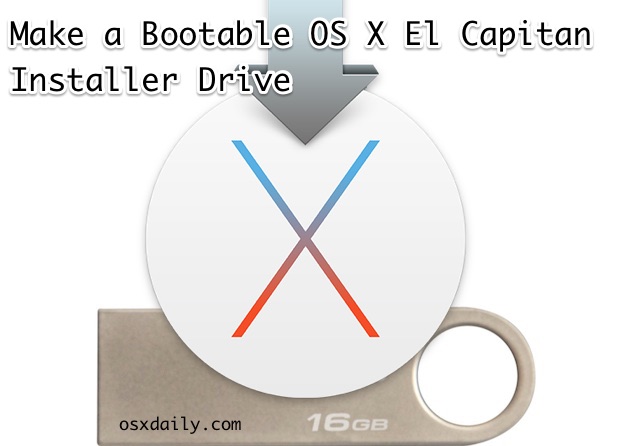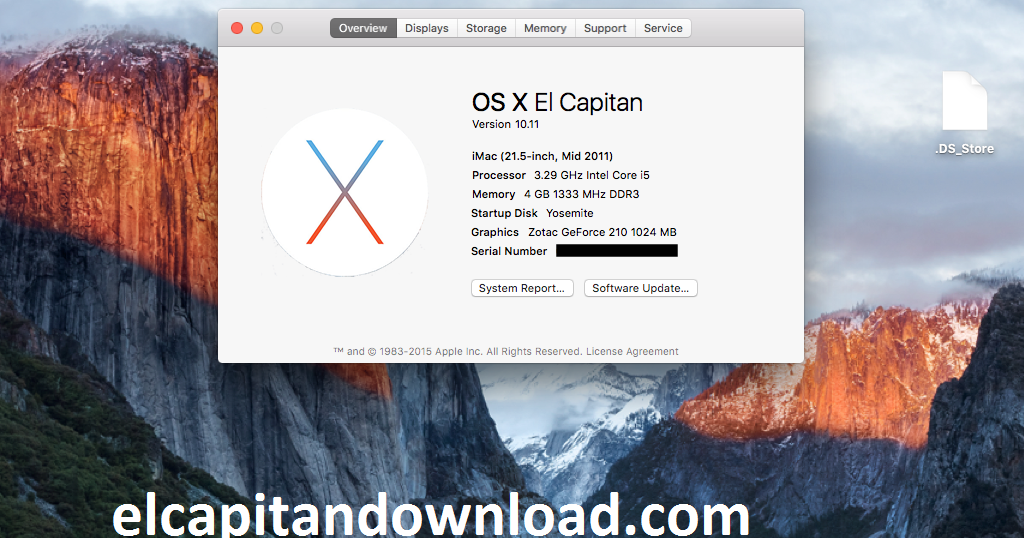Rename the USB Flash Drive to Become the OS X El Capitan Bootable Installer: The next thing you’ll. Since OS X El Capitan, built-in utilities like Startup Disk and Disk Utility won’t show drives mounted with third-party file system drivers anymore. With that in mind, we have introduced additional features in NTFS for Mac preference pane. You have to use NTFS for Mac’s Set as Startup option to boot from BootCamp partition.
Download: OS X El Capitan This will be downloaded as a disk image called InstallMacOSX.dmg. On a Mac that is compatible with El Capitan, open the disk image and run the installer within, which has the name InstallMacOSX.pkg. It installs an app named Install OS X El Capitan into your Applications folder.
There are two recommended installation methods for El Capitan download and install on your Mac PC or Laptop recommended by the Apple. Before use those installation methods you should need to have free space (around 12 GB) on your drive for keeping the installation files when installation is processing. If you do not have free space available on your drive, please use some cleaning software to clean up the drive to remove junk files and unnecessary application data and folders from the drive.
Then you must keep a backup of your previous file, folders, and applications before upgrading the El Capitan download installation. You can use a clone backup tool for backing up your Mac PC or laptop.
To create a bootable El Capitan installer drive, you need the El Capitan installer from the Mac App Store and a Mac-formatted drive that’s big enough to hold the installer and all its data. After that, right-click the USB Drive and select Restore with Disk Image; Point to your Mac OS.dmg or.iso file by clicking the add button. After that TransMac will create bootable Mac OS USB within few minutes. Then you can insert it into your Mac, hold down the option key while turn on and boot your system with this USB.
Install El Capitan Download On Empty Volume
Make El Capitan Install Usb
In this method, you will be installing the Mac OS X El Capitan on an empty drive. The volume doesn’t have any files, folders or applications. There is no any startup volume on your PC when you are going to clean install El Capitan. So you can easily use the El Capitan installer to install the OS X into the clean empty volume.
Install El Capitan On The Startup Volume
In this method, you will be installing the OS X on your existing startup volume. Here you need to keep a backup of your data stored on the existing startup volume. For install the El Capitan on your startup volume, you need to create a bootable USB installer on a separate drive (USB pen drive).
Keep A Backup For El Capitan Download Before Installing.

You need to choose a good backup tool for backing up the existing OS’ files, folders, and applications. There are many tools and applications available on the internet for backing up the Mac OS X El Capitan download.
You can check whether the created bootable drive is working properly by checking system preferences and selecting the startup disk pane and booting the backed up drive.
How To Create A Bootable Installer To Install El Capitan Download
Apple Mac Apps store allows you to El Capitan installer directly. All you need to do is navigate through the Mac Apps store and find the appropriate link to El Capitan download. Next, you need to do is to create a bootable USB installer. Before you do this step please keep more than 12 GB of free volume space to create the bootable USB installer.
Then Follow The Steps That Mentioned Below.

First of all, you need to plug in the USB drive to your Mac PC or laptop. Here you should use a second internal volume for installing the files. Then open the terminal by searching the search bar and type the command createinstallmedia and enter. As soon as you enter the above command, the system will identify the USB drive which is plug in on it. After the recognizing, the system will begin to store the El Capitan installer files on the USB. After a few minutes, the system creates a bootable USB drive that has the El Capitan installer.
Enter the following path to the terminal
/Applications/Install OS X El Capitan.app/Contents/Resources/createinstallmediaHere the El Capitan installer must be in the application folder to do this step.
Startup Disk Full Mac El Capitan

Demo: -
In this example, the El Capitan installer in the application folder and Myusb is the name of USB drive which is used to boot.
sudo /Applications/Install OS X El Capitan.app/Contents/Resources/createinstallmedia --volume /Volumes/MyVolume --applicationpath /Applications/Install OS X El Capitan.appEl Capitan Compatible Devices
iMac, Mac Book, 13 inch Mac Book Pro, Mac Book Retina Models, 17 inch Mac Book Pro, Mac Book Black and White, Xserve – 2009, 15 inch Mac Book Pro, Mac Mini, Mac Book Air, Mac Pro
System Requirements For El Capitan Download
OS X v10.6.8 or later, 2GB memory, 8.8GB storage
These advanced steps are primarily for system administrators and people who are familiar with the command line. You don't need a bootable installer to upgrade macOS or reinstall macOS, but it can be useful when you want to install it on multiple computers without having to download the installer each time.
What you need to create a bootable installer
- A USB flash drive or other secondary volume, formatted as Mac OS Extended, with at least 12 GB of available storage
- A downloaded installer for macOS Big Sur, Catalina, Mojave, High Sierra or El Capitan
Download macOS
- Download: macOS Big Sur, macOS Catalina, macOS Mojave or macOS High Sierra
These will be downloaded to your Applications folder as an app called Install macOS [version name]. If the installer opens after download, quit it without continuing the installation. To get the correct installer, download from a Mac that is using macOS Sierra 10.12.5 or later, or El Capitan 10.11.6. For enterprise administrators, please download from Apple, not a locally hosted software update server. - Download: OS X El Capitan
This will be downloaded as a disk image called InstallMacOSX.dmg. On a Mac that is compatible with El Capitan, open the disk image and run the installer within, which has the name InstallMacOSX.pkg. It installs an app named Install OS X El Capitan into your Applications folder. You will create the bootable installer from this app, not from the disk image or .pkg installer.
Use the 'createinstallmedia' command in Terminal
- Connect the USB flash drive or other volume that you're using for the bootable installer.
- Open Terminal, which is in the Utilities folder of your Applications folder.
- Type or paste one of the following commands in Terminal. These assume that the installer is in your Applications folder and MyVolume is the name of the USB flash drive or other volume you're using. If it has a different name, replace
MyVolumein these commands with the name of your volume.
Big Sur:*
Catalina:*
Mojave:*
High Sierra:*
El Capitan:
* If your Mac is using macOS Sierra or earlier, include the --applicationpath argument and installer path, similar to the way this was done in the command for El Capitan.
After typing the command:
El Capitan Create Bootable Usb
- Press Return to enter the command.
- When prompted, type your administrator password and press Return again. Terminal doesn't show any characters as you type your password.
- When prompted, type
Yto confirm that you want to erase the volume, then press Return. Terminal displays the progress as the volume is being erased. - After the volume has been erased, you may see an alert stating that Terminal would like to access files on a removable volume. Click OK to allow the copy to proceed.
- When Terminal says it's finished, the volume will have the same name as the installer you downloaded, such as Install macOS Big Sur. You can now quit Terminal and eject the volume.
Use the bootable installer
Determine whether you're using a Mac with Apple silicon, then follow the appropriate steps:
Apple silicon
- Plug the bootable installer into a Mac that is connected to the Internet and compatible with the version of macOS you're installing.
- Turn on your Mac and continue to hold the power button until you see the startup options window, which shows your bootable volumes and a gear icon labelled Options.
- Select the volume containing the bootable installer, then click Continue.
- When the macOS installer opens, follow the onscreen instructions.

Create El Capitan Usb Installer
Intel processor
- Plug the bootable installer into a Mac that is connected to the Internet and compatible with the version of macOS you're installing.
- Press and hold the Option (Alt) ⌥ key immediately after turning on or restarting your Mac.
- Release the Option key when you see a dark screen displaying your bootable volumes.
- Select the volume containing the bootable installer. Then click the up arrow or press Return.
If you can't start up from the bootable installer, make sure the External Boot setting in Startup Security Utility has been set to allow booting from external media. - Choose your language, if prompted.
- Select Install macOS (or Install OS X) from the Utilities window, then click Continue and follow the onscreen instructions.
Learn more
For more information about the createinstallmedia command and the arguments that you can use with it, make sure the macOS installer is in your Applications folder, then enter the appropriate path in Terminal:
- Big Sur: /Applications/Install macOS Big Sur.app/Contents/Resources/createinstallmedia
- Catalina: /Applications/Install macOS Catalina.app/Contents/Resources/createinstallmedia
- Mojave: /Applications/Install macOS Mojave.app/Contents/Resources/createinstallmedia
- High Sierra: /Applications/Install macOS High Sierra.app/Contents/Resources/createinstallmedia
- El Capitan: /Applications/Install OS X El Capitan.app/Contents/Resources/createinstallmedia
Create El Capitan Bootable Usb Disk Utility
Macos El Capitan Boot Disk
A bootable installer doesn't download macOS from the Internet, but it does require an Internet connection to get firmware and other information specific to the Mac model.



